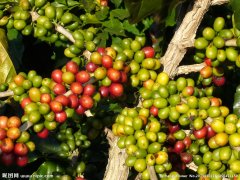Introduction to Salvadoran coffee that needs to be washed
When it comes to the Pakamara species in Saudi Arabia, we have to introduce Pacamara Manor first. In Ecuador in 1984, the fascists could buy the Pakamara Coffee Garden as the new owner. The Falesco family has been growing coffee in the Apaneca mountains since their grandparents for more than a hundred years. Urgado wanted to take a different path from his grandparents and decided to plant a new species, Pacamara, which had just been developed from the agricultural technology unit of Saudi Arabia. He found that this new species had a large and beautiful appearance, and could show a good flavor and aroma under excellent local conditions. He found new hope and found the rising star in his mind, but the first harvest turned out to be the beginning of hard work.
Pacamara bean shape is too large, in the treatment field for peeling and separation, often stuck in the holes or gaps of the machine, the machine must be adjusted from time to time to deal with separately. Due to the limited initial output of Pacamara, coupled with the fact that there are few large seeds in the country, most washing plants lack experience in dealing with large coffee fruits, not to mention extra sieves with larger mesh to specially deal with Pakamara species, so they are naturally reluctant to deal with new species. The problem of wet treatment after harvest will not be solved until 1990 when the Awasan Cooperative released its goodwill and was willing to sign a contract with Ecuador. After Urguado has no worries, with more skilled planting techniques, harvesting coffee cherries with the same maturity, and careful post-harvest treatment, finally make the Pacamara species of Pacamara estate shine! I won the 24 place in 2003, the seventh place in 2005 and the runner-up in 2008, when I and Japan's Maruyama Coffee jointly awarded the runner-up batch.
The introduction of new varieties is always a hard and high-risk attempt, not to mention the high probability of failure. If it succeeds, everyone will follow, but if we do not try to innovate, we will never wait for the chance of success. The sufferings of coffee farmers are not enough.

Important Notice :
前街咖啡 FrontStreet Coffee has moved to new addredd:
FrontStreet Coffee Address: 315,Donghua East Road,GuangZhou
Tel:020 38364473
- Prev

Costa Rican coffee beans at La Minita Manor in Tarazu District are as sweet as honey.
The strict management of Laminita Farm in Tarazhu production area has established a world-class reputation and is popular in European and American markets for most of the century. It can be called a world-famous coffee farm. Lamini Tower means a small gold mine. Before the Spanish colonization, the Indians used to dig gold in the present farm location, which can be described as a blessed land. Raminita produces about 1 million pounds of coffee beans a year.
- Next

The Honduran coffee producing area with mild acidity and slightly sweet taste introduces the San Juan Xido producing area.
The average planting height of Choluteca, Francisco Morazan, La Paz, Siguatepeque, Santa Barbara, Intibuca, Copan and Ocotepeque., is more than 1100 meters above sea level. Coffee varieties are 100% Arabica, 69% are HG, 12% are SHG,19% and CS.
Related
- Does Rose Summer choose Blue, Green or Red? Detailed explanation of Rose Summer Coffee plots and Classification in Panamanian Jade Manor
- What is the difference between the origin, producing area, processing plant, cooperative and manor of coffee beans?
- How fine does the espresso powder fit? how to grind the espresso?
- Sca coffee roasting degree color card coffee roasting degree 8 roasting color values what do you mean?
- The practice of lattes: how to make lattes at home
- Introduction to Indonesian Fine Coffee beans-- Java Coffee producing area of Indonesian Arabica Coffee
- How much will the flavor of light and medium roasted rose summer be expressed? What baking level is rose summer suitable for?
- Introduction to the characteristics of washing, sun-drying or wet-planing coffee commonly used in Mantenin, Indonesia
- Price characteristics of Arabica Coffee Bean Starbucks introduction to Manning Coffee Bean Taste producing area Variety Manor
- What is the authentic Yega flavor? What are the flavor characteristics of the really excellent Yejasuffi coffee beans?

